Click here for Part II of this article.
One Holy, Catholic (Universal) and Apostolic Church
When most people think of the Church (Gk: Εκκλησία, Ecclesia), they immediately think of the church building, the bishop and the clergy. While these elements may define other, heterodox churches, they fall exceedingly short of the full scope of the Orthodox Church.
“Ecclesia ” does not connote a physical structure, but all those who gather for corporate worship “in spirit and in truth” (John 4:24). The correct term for the physical structure built for this purpose, is not “the church” but “the temple” (ναός, naos). While beautiful temples are a blessing to have, they are not a pre-requisite for a functioning Church. Indeed, they did not come into existence until after Constantine I signed the Edict of Milan in 313 AD. Prior to that, Christians gathered for worship secretly in forests, private homes, catacombs, and anywhere else they could to avoid persecution. And yet, the New Testament writings are brimming with the word “Church.”
According to Saint Porphyrios of Kafsokalyvia, the Orthodox Church is beginningless, uncreated and pre-eternal, first existing in the communion of the three, blessed Persons of the Holy Trinity. All the angelic powers (those that did not fall) also belong to the Church, as do all the saints of the Old and New Testaments. In addition to these, all those who lived and died in an Orthodox manner, together with all those currently living a sacramental and liturgical Orthodox life, while championing and believing in the Orthodox Faith, are also members of the Orthodox Church.1
Who are those Christians who live a sacramental and liturgical life while championing and believing in the Orthodox Faith? In the early Church, they were the ones who celebrated the Divine Liturgy on a daily basis; and then on a weekly basis, when their numbers grew too large to make daily corporate worship practical. They were the ones who sold everything they had and gave it to the Apostles to distribute equitably amongst all the Christians in the community of believers. They were the ones who put the Lord, Jesus Christ, first in their lives, adhering to all His teachings, and witnessing to the Faith, even with their lives, which many of them did. This defines who belongs to the true Orthodox Church on earth.
The true Church on earth strives with all Her might to cross the finish line and join the Heavenly Church, like Saint Paul who said, “I have fought the good fight, I have finished the race, I have kept the faith.” (2 Timothy 4:7). This Church is “hot” for God (Revelations 3:16) and does not care if they are called “extremists,” “fundamentalists” or “fanatics.” This Church teaches their children to become martyrs for Christ, like St. Sophia who urged her daughters to endure their torments for the sake of the Heavenly Bridegroom. All three maidens were beheaded, joyfully bending their necks beneath the sword, while their mother was forced to watch their sufferings, until she died by their graves of a broken heart. This Church endures these things because of Her unshakeable faith and ardent love for Jesus. These people forgive and love their enemies, make sacrifices for others, pray constantly and never miss a Liturgy except for grave reasons. Missing Church because of “other” commitments is not negotiable for these Christians because the Divine Liturgy, which brings Heaven to earth and unites them to their Lord and Savior, is their first commitment.
Today, many go to the temple but only for Christmas, Pascha, a memorial service, or if it is “convenient.” Others may go more often and may even pay a membership, but do not live out Christ’s commandments; or they may not participate in the salvific sacraments even if they attend Liturgy regularly, because they may be unrepentant or they may be avoiding Holy Communion for fear of germs, or they may even think they have no sins. Others may not be standing up for their Orthodox Faith when the opportunity comes; they may be too afraid, or even embarrassed. Still others may be living an unrepentant dual life, committing abominable sins when they are not attending services, like reading coffee cups, or fornicating, or committing violence in the home. Today, there are many who are in the Church but are not of the Church.
It should come as no surprise that this condition, to be in but not of, began when the persecutions against the Church stopped. While the sword was the test of true Church membership, the Church was authentic, purified by the Blood of Christ, but also by Her own blood that She shed for Him. When the persecutions ended, many joined the Church because it became easier, safer, more convenient or more popular to be a Christian, thereby increasing the number of insincere or lukewarm people in the Church but not of the Church. Such has been the condition of the Church for a very long time now, but that will turn around again as we approach the end times when persecutions increase, from without and from within. Many dread those times because they fear difficulties, torment, martyrdom or death, but only through suffering can the Church, the Bride of Christ, prepare herself for God.

Do you support freedom of worship for the Ukrainian Orthodox Church enduring martyrdom as you read this? Then please read, sign, and share our petition supporting Metropolitan Onuphry and his Church. Their burden today, ours tomorrow.
Saint Paul defines the Church as “the mystical Body of the Godman, Christ “(Ephesians 1:22-23; Colossians 1:24). “Christ, [therefore, and not a pope, not a patriarch, nor a bishop] is the Head of the Church, His body, and is Himself its Savior” (Ephesians 5:23). Because all have sinned, “Christ…loved the Church and gave Himself up for Her, that He might sanctify her, having cleansed her by the washing of water by the word, so that He might present the Church to Himself in splendor, without spot or wrinkle or any such thing, that She might be holy and without blemish” (Ephesians 5: 25-27).
As Christ is one, so His Mystical Body – His Bride – is one. Therefore, the Church can only be one, the one that He built and passed on to His Apostles. This one, true Church can only be the Orthodox Church, as She alone has continued Christ’s truth (dogmas) and life (ethos) according to His true saying, “I am the way, the truth and the life,” (John 14:6). This Way, this Truth and this Life, have been handed down to us by Christ, through His Holy Apostles, and their successors, in an unbreakable chain known as the Apostolic Succession. “… Christ, Himself, gave the apostles, the prophets, the evangelists, the pastors and teachers, to equip his people for works of service, so that the body of Christ may be built up until we all reach unity in the faith and in the knowledge of the Son of God and become mature, attaining to the whole measure of the fullness of Christ” (Ephesians 4: 11-13). In his letter to R. Gardiner, Hieromartyr Hilarion (Troitsky) wrote, “The Church is One, and She is the only place where one can receive the complete and unabridged plenteousness of the gifts of the Holy Spirit…There is no Christianity outside of the Church for us. If Christ founded the Church, and the Church is His Body, then separation from his Body means death” (On Life in the Church).
The Church Gave us the Bible and Holy Tradition
Christ’s teachings have also been handed down to us through the Holy Scriptures (the Word of God) and Holy Tradition. According to St. Nektarios, Holy Tradition can be thought of as the unwritten book of the New Testament2, which is the life of the Holy Spirit in the Church as lived by Christ Himself, by His Apostles, by His saints (many of them bishops), and by the Ecumenical Councils, having correctly interpreted His teachings by the Holy Spirit of Truth.1
Some Christians say they don’t need the Church. “All we need is the Bible, Sola Scriptura.” These souls ignore how the Church (those who gather for corporate worship “in spirit and in truth”) preceded the Bible, and under the guidance of the unerring Holy Spirit wrote, guarded and rightly interpreted the Bible. It is impossible for the Holy Spirit of Truth to inspire differing or conflicting interpretations of the Bible, which is why outside the Orthodox Church, all manner of strange ideas and false heresies have arisen. Different sects holding opposite doctrines appeal to the Bible equally because they ignore Holy Tradition and rely entirely on their own private interpretations, despite God’s clear warning which is recorded in the Bible: “No prophecy of scripture is of private interpretation. For no prophecy ever came by the will of man, but holy men of God spoke as they were prompted by the Holy Spirit” (2 Peter 1:20). No one can interpret Scripture by himself, because we are one body, told to “be of one mind” (Phil. 1:27). “Be one in thought, one in heart, one in soul, one in mind” (Phil. 2:2). Thus, “I believe in the Bible,” must be balanced with, “I believe in One, Holy, Catholic (universal) and Apostolic Church,” which is the Orthodox Church.3
The Orthodox Church, therefore, is not a man-made religion. It is through this Church, His Church, that God, both revealed and explained Himself, so that we may truly understand and know Him without any doubts. This is not blind faith. This Faith has stood the test of time and was proven by the miraculous signs and wonders of our Lord, Jesus Christ, even as far as His Incarnation and Resurrection from the dead. Our God knows the weaknesses of our human condition and has given us all the evidence we need to believe – if we bother to look for it.
The Orthodox Church is the fulfillment of the Old Testament’s prophesied Blood Covenant that extends Heaven to earth in the life of the Godman, Christ, which we experience in the Church’s Divine Liturgy. In other words, the Kingdom of God is manifested in the life of the Church.1 To find the Orthodox Church, is to find the pearl of great price (Matthew 13 45-46) and the narrow gate (Matthew 7: 13-14) – narrow because the Church teaches only one (absolute) Truth and only one Way (to find it). The wide gate that leads to destruction has room for many ways, many so called convenient “truths.” These relative truths represent the many ideologies or “paths up the mountain,” but only one Path reaches to the top of the mountain. The other paths swerve and go elsewhere. Because there is only one Truth, one Trinity, one God, one Head, and one Body, there can only be one Path, one Bride, one Church, which makes the one and only Way, narrow. If one deviates from this Path, this Church, one does not get to the Kingdom of Heaven at the top, despite what some “orthodox” bishops may have recently said.

Proper Selection of Clergy and Bishops
The members of the Orthodox Church are meant to relate to one another as the three Persons of the Holy Trinity Each relate to the Other – in all humility and love. This is why during the first several centuries of Christian history, the Church elected Her bishops. The Didache, an early Christian document, states “you must elect for yourselves bishops and deacons who are a credit to the Lord, men who are gentle, generous, faithful, and well tried.” St. Cyprian, Bishop of Carthage (200-258 AD), also advocated for the election of bishops by the Christian community. In the fifth century, Rusticus, Bishop of Narbonne, ordained his archdeacon Hermes and sent him as bishop to the people of Beziers. The people sent Bishop Hermes right back to Rusticus because he had neglected to consult with and receive approval from them.3
“Christ did not establish His Church to be ruled by…dictators, but by good shepherds – the shepherds who imitate their Lord and God, the original Good Shepherd – shepherds who know their sheep, love them, and give their life for them – shepherds who do not carry a crown but a towel and are footwashers.” 3
The laity, too, are ordained through the sacrament of Chrismation to participate in the work of the Church. Therefore, the clergy must operate interdependently with the laity and not independently of the laity, since they are both part of the same Mystical Body, the Church. Prior to 1923, the Patriarch of Constantinople was elected by a mixed council of eight lay people and four metropolitans. Patriarch Alexei of Moscow was elected by 66 bishops, 66 priests, and 66 lay people representing the 66 dioceses of the Russian Church. This process reflects the true Tradition of the Church, where the laity help select their own clergy who are to serve them. This is not democracy, but syndiakonia (συνδιακονία), or interdependence, working together as members of the Body of Christ in symphony, love and doxology to the Lord.3
Although education is desirable and a blessing, in our Orthodox history, there was never a requirement for a priest candidate to first earn a Degree in Theology. Fr. Dimitios Gagastathis’ biography reminds us that at the conclusion of the Balkan Wars, the minimum educational requirement for the priesthood was to complete a “6th grade education.” Even today, in Greece, and likely in other countries as well, there exist priests with only a high school diploma, or less. Many older Orthodox Christians may recall how their village priest was often nominated from the local community. Educational barriers to enter the priesthood were not established by Christ or the Apostles. St. Porphyrios of Kafsokalyvia had a Grade 2 education when he went to Mount Athos, but subsequently became a priest and a Saint, blessed with many gifts of the Holy Spirit. Even St. Paisios of Mount Athos said that the only requirements for the priesthood are faith and reverence (πίστη και ευλάβεια). This is important for the subsequent scrutiny of those who wish to join the ranks of the clergy.

There are, of course, highly educated bishops as well, such as the Three Holy Hierarchs – St. Basil, St. Chrysostom and St. Gregory the Theologian – but they also had faith and reverence. Arius, who was highly educated, was an irreverent heretic who was anathematized. Education is beneficial but should never be the sole criterion to fulfil Christ’s commandment to St. Peter, “…tend my sheep” (John 21:17). If there is faith and reverence for the Holy Trinity, the Holy Spirit completes any “education” that may be lacking. Many bishops of the Orthodox Church were also monastics for many years before becoming bishops and saints. They were often selected against their personal will but according to God’s will. This is because they were holy and humble men of God with no personal ambition, other than to serve Christ and His Church. Some examples include St. Basil the Great, St. Philaret of Moscow and St. Nektarios of Aegina. Men such as these, and all of the saints, had exemplary faith and reverence.
Even if the laity select their priest or bishop, when the ordination is performed, it still requires their unanimous consent. During the service, the congregation ratifies the ordination by shouting AXIOS! which means WORTHY! If any clergy or lay person expresses dissent, the ordination or consecration must not take place until an investigation is made. The Church is a communion of self-governing churches, held together not by a single bishop wielding absolute power, but by a communion of all its members, clergy and laity; a communion with one another and in the Holy Trinity, united in one Body, the Body of Christ through the Holy Eucharist. The Holy Spirit abides not just in the bishops, but in the entire body of the Church.3
Imposed Clergy and Bishops
Today, however, these Apostolic Traditions are rarely practised. The Orthodox priest candidate of today, attends an Orthodox Theological Academy, is ordained and is then “assigned” to a parish. Rarely, as was done in the past, is a priest chosen by the parish for the parish. How many of today’s parishioners have met or spoken to their candidate priest or bishop, or seen their biography, or been invited to interview them or to participate in the selection process? Today, more and more, especially in the Eastern Orthodox Church, the priest or bishop is selected by the hierarchy for the hierarchy, is parachuted into his new parish or jurisdiction, and the laity deals with it.
Furthermore, when was a bishop in the Eastern Orthodox Church last selected by the laity from the monastic community? In fact, many hierarchs in North America today hold a polemic stance against popular (especially male) monasteries, whose ordained monks can serve Liturgies and Sacraments without having to rely on the regional bishop to provide a priest. Canadian monasteries have had “stand-offs” with their archbishop over liturgical innovations imposed due to Covid. Orthodox faithful in Canada have been publicly shamed by their archbishop for frequenting some monasteries and using those monks as their spiritual father confessors. Other bishops in the US have openly and vehemently urged their parishioners to shun their local monastery, a hostility that threatens to push some monasteries into bankruptcy. Why anyone would not want to support the prayers of their local monastic community defies reason. Except of course, if the Abbot or Abbess inconveniently disagrees with the erring local bishop on matters of Faith or if there is a monetary or competitive issue.
Even married clergy have troubles. If, for any reason, a decent priest displeases his bishop, or if a good bishop disagrees with his archbishop, he runs the risk of being arbitrarily deposed or reassigned to another part of the country (together with his family), regardless of how many of his parishioners oppose the move. Traditionally, a priest or bishop remained with his parish or episcopate until grave illness or death prevented him from serving. Untimely removals have created bereavement in entire parishes, impeding the spiritual growth of the parish by disrupting spiritual father-child relationships and bonds that have taken years to develop. Such premature removals are too frequently a punishment for some slight, or an abusive execution of power and control that bishops were never meant to have or wield. Understandably, we see fewer and fewer men seeking the priesthood, and these same bishops wonder why. Christ forbids bishops from using their position to abuse the clergy, to compete in the ecclesial arena, or to demand obedience or respect. Christ and His Apostles never behaved that way.
Hierarchy and Humility
When Christ’s Disciples vied amongst themselves for honor, He said, “the first will be last and last will be first” (Matthew 19:30) and “by this shall all men know that you are My Disciples, that you love one another as I have loved you” (John 13:34-35); and “…the rulers of the Gentiles lord it over them, and their high officials exercise authority over them. Not so with you. Instead, whoever wants to become great among you must be your servant, and whoever wants to be first must be your slave – just as the Son of Man did not come to be served, but to serve, and to give his life as a ransom for many” (Matthew 20:25-28). He berated the Pharisees for their hypocrisy and their love of honor, of loving greetings in the marketplace and of the best seats (Matthew 23:6-12); but to His Disciples He said, “do not be called ‘Rabbi’ [which simply means Teacher]; for One is your Teacher, the Christ, and you are all brethren [brothers].”
Christ did well to teach humility to his Disciples; for the Word of God, the Creator, who is the Head of His Mystical Body, the Church, and Who was ordained High Priest by the Father, did not come to us as the CEO of Paradise. He was born in a stable, the humblest of the poorest, fled as a refugee, was raised in a town of ill repute, worked as a carpenter, walked everywhere, teaching and healing the sick and the lame, having no home, no place to rest His head (Matthew 8:20). He took no payment. He prayed and fasted, hungered and thirsted. Towards the end of His earthly ministry, the Master of the Universe washed His Disciples’ feet, teaching us and our clergy, to do the same to one another, not pseudo-symbolically, but fundamentally, in humble service. Next, the Lord of all submitted to betrayal, injustice, humiliation, brutal torture and death. Naked, He spilled His blood on a Roman cross, giving us His broken Body and Blood for our salvation, so that we can become permanent members of His Church.
If we look at the Church as an organized structure, Christ put Himself at the very bottom so that He could elevate His Church to the very top granting Her theosis. If our present-day bishops want a Christ-like status, they need to significantly lower themselves relative to their flock of logical sheep in service to them. As Christ said, “the Good Shepherd lays down His life for the sheep” (John 10:11). Unlike the CEO in the corporate example, Christ, the Good Shepherd, elevated His sheep, to the very top of the hierarchical ladder, while putting Himself, the Head of the Church, at the very bottom because of His unfathomable condescension, His ultimate self-sacrifice and His incomprehensible Love. It was not by His power and glory that He saved us, but by His extreme humility. He placed Himself at the bottom so that by imitating Him, the Lord of all, we may rise to the top; and if His faithful sheep follow Him into the depths of humility in Spirit and in Truth, what then is the true role of the Church’s bishops, if not an even deeper humility, in service to the sheep?

Illumined and emboldened on the day of Pentecost, the Apostles then spread the Gospel, their Teacher’s message, performing miracles in their Teacher’s name, not their own message in their own name (see Kolymbari below), and not for money, power or prestige, but to witness to the Truth, even unto martyrdom – and millions of Christians subsequently did the same. Christ had taught that the world would hate them because it hated Him first (John 15:18). It did and it still does. He said that He was not of this world, and so they forsook the world. They did not seek status, only service, because their own Master, the Creator and Lord of all, came to serve, and to do so in all obedience to His Father in Heaven, and in all humility for His Bride, the Church.
The first bishops were saints who took care of their flock while living in poverty, many dying as martyrs in the line of duty. When the flock grew too large to be overseen by one person, the bishop, ordained by “the laying on of hands” (Num 27:15-23; Deut 34:9, 2 Timothy 1:5 ) other bishops, presbyters or deacons. The Apostles, themselves, ordained deacons, one of whom was Saint Stephen, the first martyr. Why deacons? They were needed for the very lack-luster job of overseeing the serving of tables at the agape meals; to make sure that everyone got their fair share so that no one felt slighted. The purpose of all these jobs was to serve the laity, the Church, the Body of Christ, to feed them physically and spiritually, to heal and comfort them, to serve and die for them. The Apostles would gather the donated funds of the believers for equitable distribution to all, according to the needs of each. St Paul worked as a tentmaker to support himself while undertaking his missionary journeys, so as not to financially burden the Churches he established. Once he collected funds on his missionary journeys to support the Church in Jerusalem, which had great need.
Nowadays, there are bishops who gather funds from the faithful but not for charitable work. They demand stipends from their Orthodox parishes even when the parish has a large mortgage and pays the salary of the priest. They have created the prestigious lay position of “Archon” as an incentive for large donations from those who wish to show off their wealth and generosity; and if the Philoptochos does a fundraiser, they expect a generous cut because their cash flow is low, having horded all their surplus income in fixed assets or having sent large sums to the Constantinopolitan patriarchate for reasons of their own. What a stark contrast to St. Basil the Great, Bishop of Caesarea, who sold everything he owned and gave the money to the poor. He even used his own funds to establish the ‘new city’ of Basilieas to care for the elderly, the sick and the poor. This is true Christianity, and it is by no means impossible or extinct, for I have personally met bishops and other clergy who live in poverty, having donated all their inheritance to the service of God, as St. Basil did, but I shall not name them for they are still alive. I cannot recall a single act of Christian charity from the bishop of our Greek jurisdiction in North America. I have only witnessed demands and income-generating business schemes. I hope things are different in your neck of the woods, but they probably aren’t.
Most of us have observed how the episcopate (position of bishop) has even become a fashionable career. The mitre (crown) and other trappings, which appeared in the 16th century, are garment copies of Byzantine emperors. Such crowns, and their associated bells and velvets have literally and figuratively “gone to the heads” of some modern-day hierarchs, who assume greater authority than conferred to them and abuse their position. Along with the mitres, they have adopted various titles of episcopal grandeur, such as ‘your grace’, ‘your eminence’, ‘your all-holiness’ and so on, when there is no higher ordination than that of “bishop.” While we refer to God as “Lord,” (Κύριε, Kyrie) we address a bishop as “lord, lord” (κύριε, κύριε) twice, followed by his first name. Other Christian denominations see these things and question how they relate to the first few centuries of the Orthodox Church.
In sharp contrast to our present-day hierarchs, the Apostles referred to themselves in their epistles as “bondservants” and “apostles of Jesus Christ through/by the will/commandment of God.” The Apostles, who ordained the first bishops, made it clear that their apostleship was not something they chose to honor themselves with, but something chosen for them by God; and their obedience to God’s will made them bondservants, which means slaves, because they considered themselves bought by the Lord’s blood. This terminology is diametrically opposed to today’s cornucopia of terminology denoting hierarchs and other clergy. The assortment of ecclesial titles used today is much loftier than the appellation “teacher,” which Christ said was too lofty, even for His Disciples, because He, the Lord of all, called Himself, “the Teacher,” and them, brothers to one another.
Synodical Organization
Christ taught His Disciples by His example from the bottom of the hierarchical ladder, and they in turn, served the Church sacrificing themselves for Her, as Christ had also done. Guided by the Holy Spirit, they organized the Church as she grew, by carefully selecting, teaching and ordaining their helpers and successors. This gave rise to an Apostolic Succession of bishops, meaning overseers or caretakers. Bishops then, fell into the same four categories we have today: bishop (επίσκοπος), metropolitan (μητροπολίτης), archbishop (aρχιεπίσκοπος) and patriarch (πατριάρχης). These are all administrative roles depending on the geographical area they supervise and its size. Initially there were five Patriarchs (in Rome, Constantinople, Jerusalem, Antioch and Alexandria), called the Pentarchy (five heads). The Pentarchy did not rule the Church and were never meant to impose their authority upon any of their fellow bishops. Nor did they interfere in the region (see) of another patriarch, as Patriarch Bartholomew has repeatedly done.

When issues or problems arose in the early Church, they were never solved by a papal top-down approach. First, the Apostles and later, their successors (bishops), would all meet in conciliar humility to find solutions together, with prayer and brotherly love, equitably and collectively so that the Holy Spirit could do His work. This was called an Ecumenical (universal) Council or Synod, where all types of bishops, having the same ordination and the same ecclesial authority, cast a vote of equal weight. This was the case in all seven past ecumenical councils. Unfortunately, in recent times, this has become another usurped area.
Imposter Bishops
When Patriarch Bartholomew of Constantinople called an “ecumenical” synod in 2016 in Kolymbari, Crete, it was hoped that he would follow the same Holy Tradition as past synods. For several decades, Orthodox Autocephalous Churches had been preparing the ground for a much needed Great (Ecumenical) Pan-Orthodox Synod. The list of topics had been painstakingly agreed upon over many years. However, when Bartholomew called for a Great and Holy Synod in 2016 all past visions to resolve multiple contemporary issues vanished, simply because the agenda was “hijacked” and altered by the See of Phanar (Constantinople, aka Bartholomew) and because the organizers insisted on restricting attendance, presumably to ensure sufficient votes to pass their agenda. Traditionally, all Orthodox bishops have a seat at the Synodic table in the spirit of the original Day of Pentecost, where all Apostles gathered. However, when most Russian Orthodox bishops were told they could not attend, (presumably so the vote count would not be skewed in an “undesirable” direction) this resulted in the absence of half the global Orthodox population of bishops.
There were other important reasons for the boycott as well, including violations of the Patristic interpretation of the word “Church,” which is described in detail at the start of this article. The Kolymbari synod was set on declaring sects as “Churches” and reducing the One, Holy, Catholic and Apostolic Church to the same level as all other heresies. By these means, Patriarch Bartholomew attempted to uncanonically undo key elements of Holy Tradition – Patristic teachings of the Holy Fathers and the work of the Second Ecumenical Council in 381 AD that struck the Nicene Creed of Faith, which was inspired by the Holy Spirit. This was only one of many highly controversial agenda topics that also drove other Autocephalous Orthodox Churches to boycott the proceedings. We explained earlier that it is impossible for the Holy Spirit of Truth to inspire conflicting interpretations of the Bible; but according to Patriarch Bartholomew, the Holy Spirit “corrected” Himself at Kolymbari by admitting, centuries later, that the Orthodox Church is not the One, Holy, Catholic and Apostolic Church because all other churches are just as salvific and as valid as She. If Patriarch Bartholomew believes this, then when he recites the Nicene Creed of Faith during Orthodox services and says, “I believe in One, Holy, Catholic and Apostolic Church” who is he lying to? These things are not of the Holy Spirit but of the “other” spirit. “…do not believe every spirit but test the spirits to see whether they are from God, because many false prophets have gone out into the world” (1 John:4). An uncanonical and un-ecumenical slanted synod is no synod, and its decisions have no validity. The other bishops who were present, and signed the decisions of this pseudo-synod, are also wrong and must recant their signatures if they ever hope to be trusted or taken seriously by the Orthodox people again. So far, that has not yet transpired.
It is for this reason that many Orthodox faithful, who want an authentic Orthodoxy, left their Greek, Romanian and other “Orthodox” Churches (those that voted in favor of the Kolymbari resolutions) for parishes in other Orthodox jurisdictions that did not attend or sign. Others have tragically left the Orthodox Church altogether because of unprecedented scandals too numerous to mention. This is most unfortunate because Christ said, “If anyone causes one of these…who believe in me to stumble, it would be better for them to have a large millstone hung around their neck and to be drowned in the depths of the sea. Woe to the world because of scandals. Such things must come, but woe to the person through whom they come!” (Matthew 18:6-8).
One may ask, why must such things come? If the Orthodox Church is the one, true, Church of Christ, how is it possible for any of Her bishops with their Apostolic succession, to arbitrarily change, defy and oppose Her Doctrines and Holy Traditions? Why does a just God put up with these types of scandalous bishops in His Church? To be continued….
—Demetrios Georgiou
Click here for Part II of this article.
- Hieromonk Savvas of the Holy Mountain. Healing the Soul – Saint Porphyrios of Kafsokalyvia as a Model for our Lives. Translated and edited from the Greek original by the Sisterhood of the Saint John Chrysostomos Greek Orthodox Monastery, Pleasant Prairie, Wisconsin, 2021 (Ecclesiology, pp 61-63)
- Saint Nektarios Kefalas. Holy Catechism – volume 14. Virgin Mary of Australia and Oceana, 2022, pp 11.
- Anthony M. Coniaris. Living a Balanced Life in an Unbalanced World. Light & Life Publishing Company, Minneapolis MN (Chapter 6, pp 70-73; Chapter 11 pp 106-108)
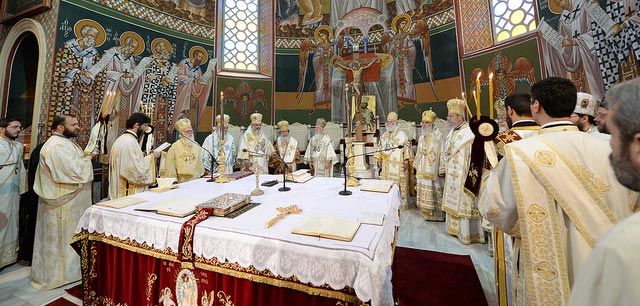
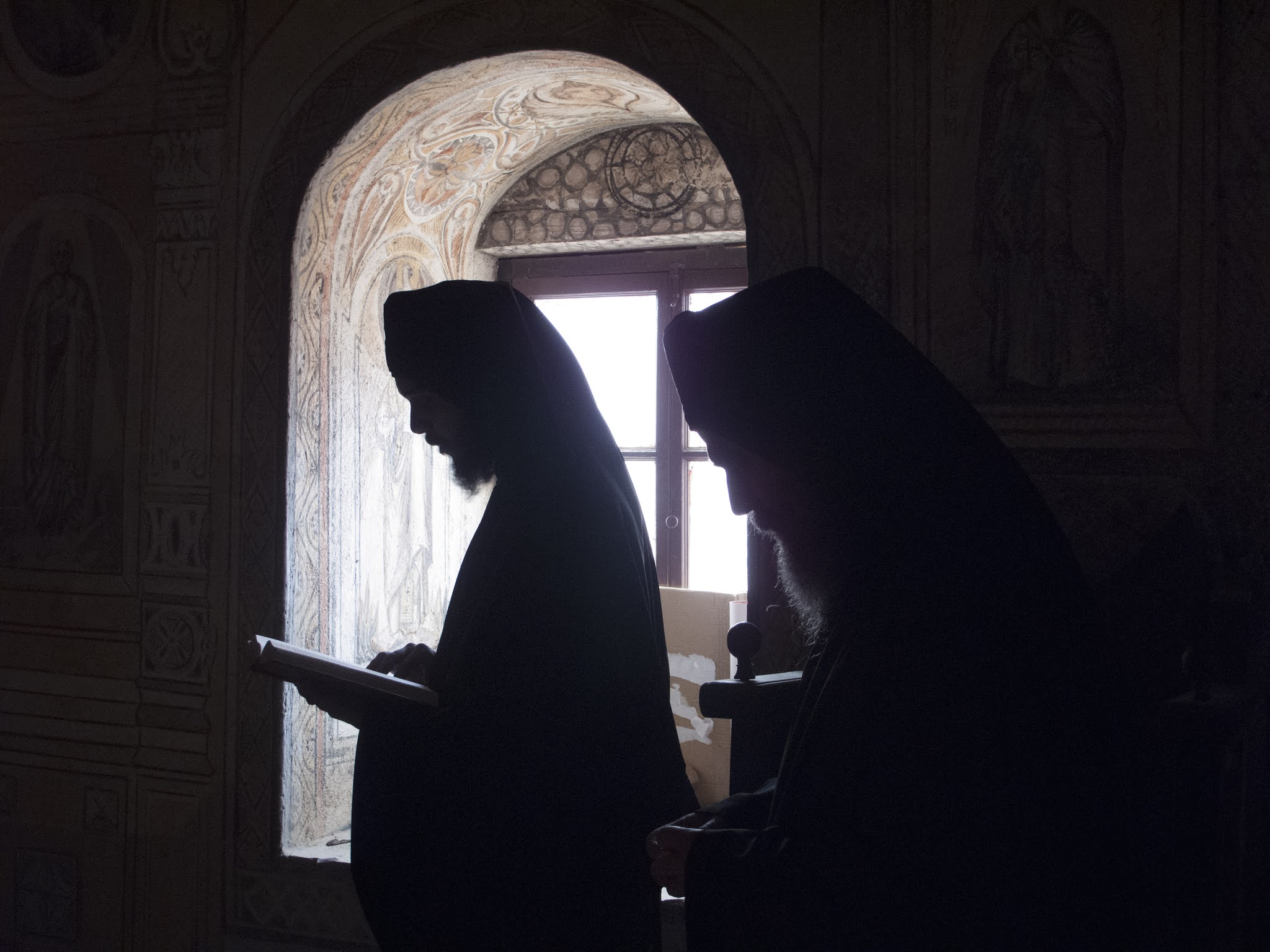
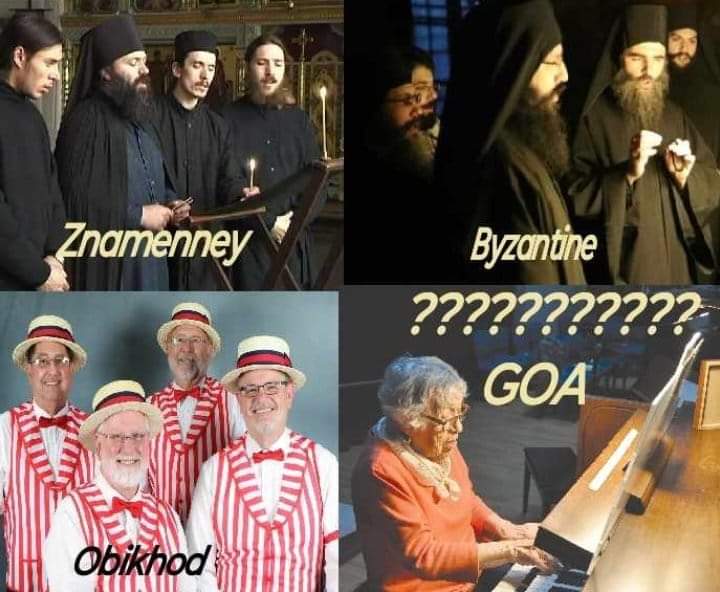




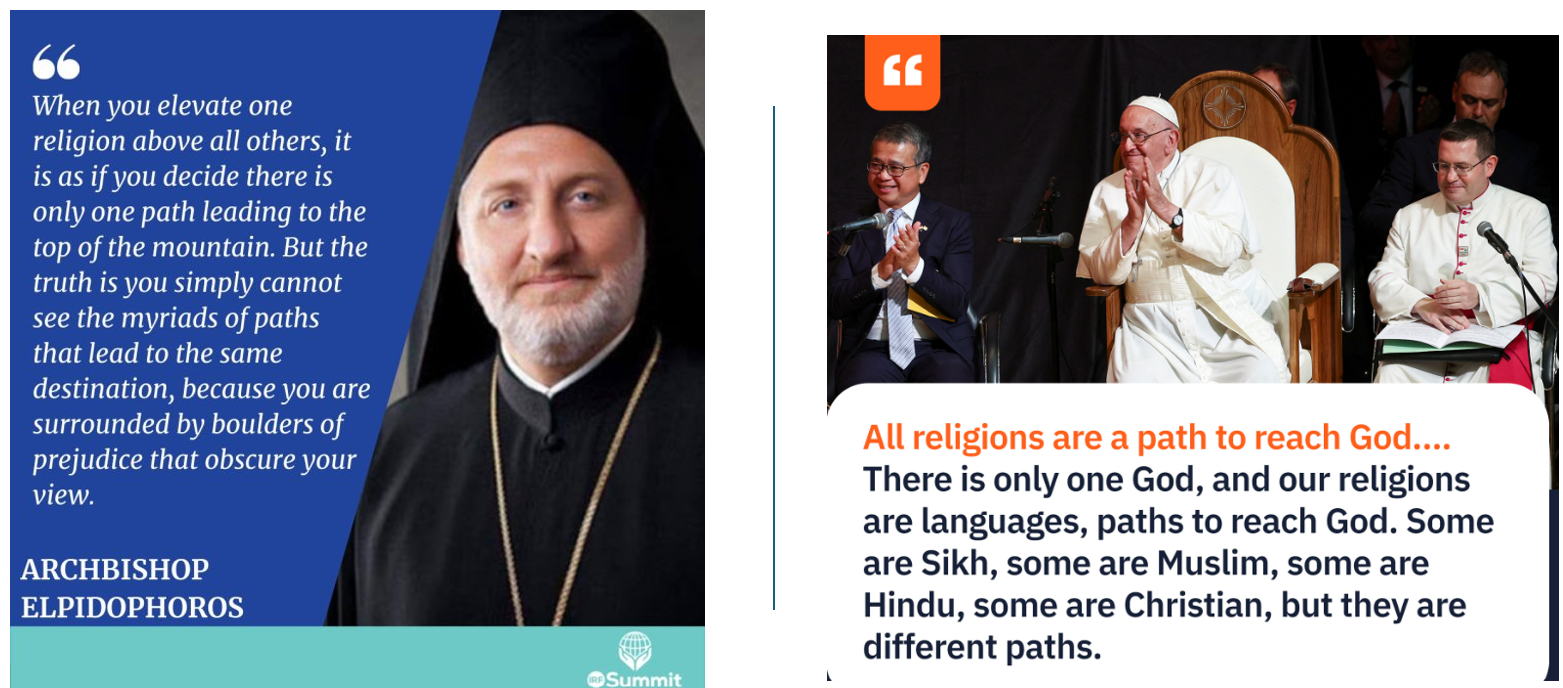


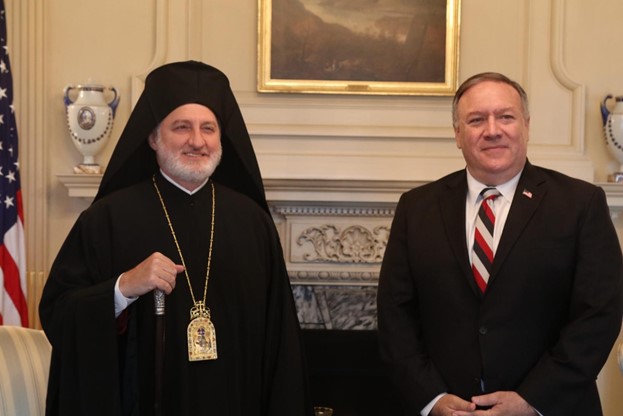
 Elpidophoros with then-U.S. Secretary of State Mike Pompeo in New York in Sept. 2020.
Elpidophoros with then-U.S. Secretary of State Mike Pompeo in New York in Sept. 2020. Archpriest Fr. Saša Petrović of Omaha, Neb.
Archpriest Fr. Saša Petrović of Omaha, Neb.
 GOARCH Bishop Athenagoras has since apologized for his 2023 appearance at an interfaith event in New Jersey.
GOARCH Bishop Athenagoras has since apologized for his 2023 appearance at an interfaith event in New Jersey.
 Elpidophoros speaks about “Russia’s Weaponization of Religion in the Ukraine Conflict” at the National Intelligence University. But what about the United States’ weaponization of religion in the region?
Elpidophoros speaks about “Russia’s Weaponization of Religion in the Ukraine Conflict” at the National Intelligence University. But what about the United States’ weaponization of religion in the region? Then-U.S. Secretary of State Mike Pompeo with EP Bartholomew in Istanbul in Nov. 2020.
Then-U.S. Secretary of State Mike Pompeo with EP Bartholomew in Istanbul in Nov. 2020. Do Americans realize, or even care, that their government’s destabilization of and warmongering in Ukraine have led to the persecution of Orthodox Christians there? Above, His Eminence Metropolitan Longin of Bancheny after his
Do Americans realize, or even care, that their government’s destabilization of and warmongering in Ukraine have led to the persecution of Orthodox Christians there? Above, His Eminence Metropolitan Longin of Bancheny after his 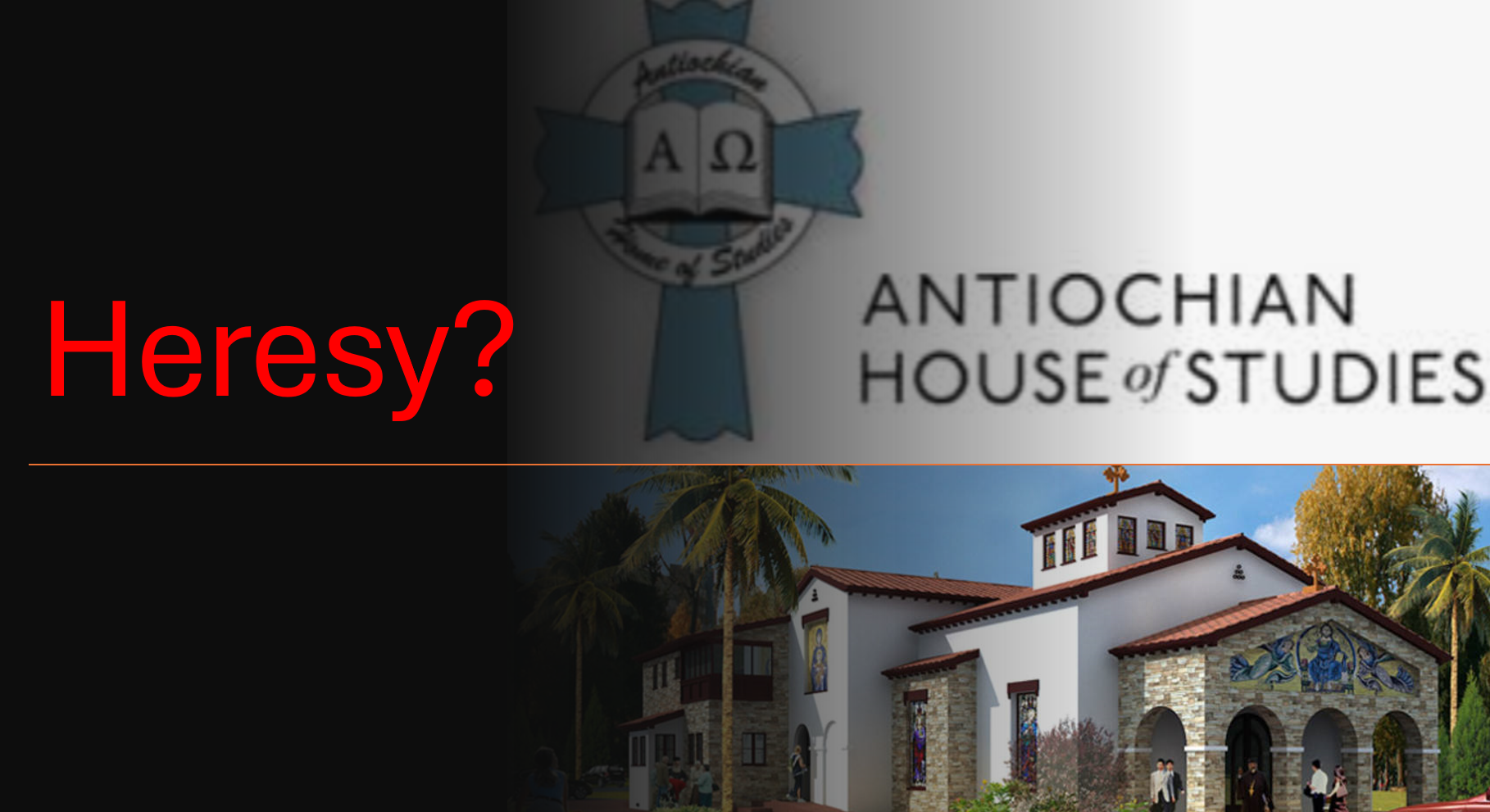






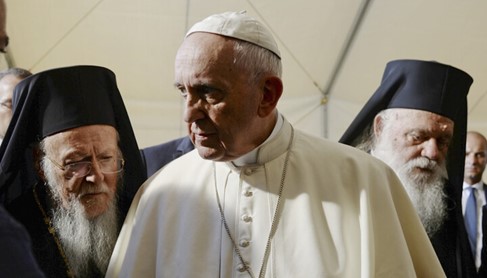
 Please pray for these men without chests, EP Bartholomew, Pope Francis, and Archbishop Ieronymos.
Please pray for these men without chests, EP Bartholomew, Pope Francis, and Archbishop Ieronymos.
 Please pray for Archbishop Elpidophoros & Co.
Please pray for Archbishop Elpidophoros & Co.
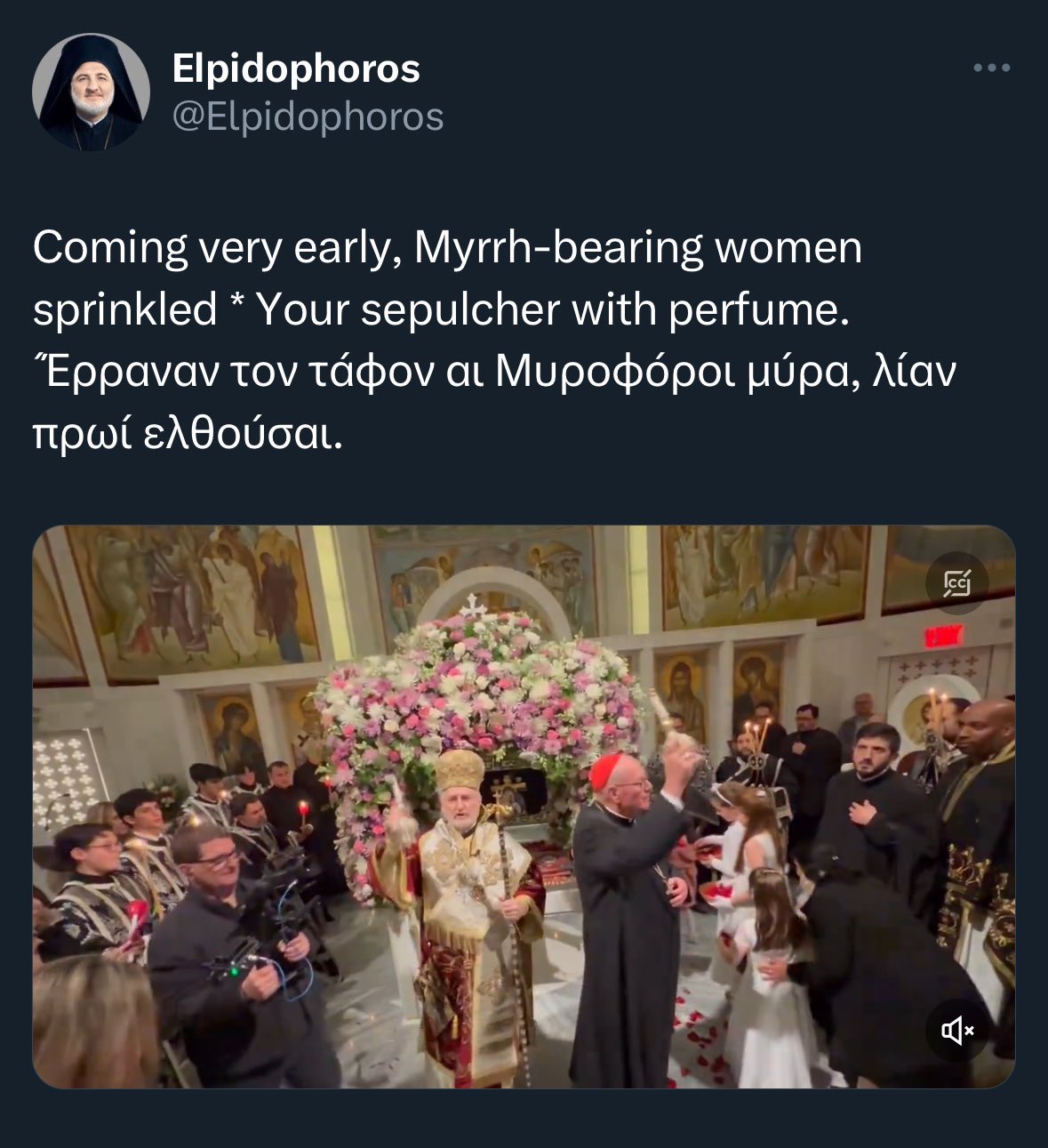














 Therefore, if some of us lament the abysmal quality of some hierarchs in the Orthodox Church today, listen to what Christ said to His Disciples: “Did I not choose you, the twelve? And yet one of you is a devil?” (John 6:70). Being the all-knowing God, and not interfering with the free will of His creatures, but giving them every opportunity to know Him and follow Him, Jesus knew in advance that Judas Iscariot, despite following Him closely for three years, would betray Him. He knew he would do it with a kiss and would not seek forgiveness, but would destroy himself. Christ gave Judas every opportunity to repent, but when Judas would not return to the Master, the Master used the devil to abolish the devil’s power over us by allowing his freely made choices to play out. Although one of the “twelve,” Judas did not cultivate the rock-like faith required for the gates of hell not to prevail against him. He succumbed to his final temptation, becoming “the son of perdition” (John 17:12). He was in the Church, but he was not of the church – a condition of the heart and mind that can apply to anyone, including bishops.
Therefore, if some of us lament the abysmal quality of some hierarchs in the Orthodox Church today, listen to what Christ said to His Disciples: “Did I not choose you, the twelve? And yet one of you is a devil?” (John 6:70). Being the all-knowing God, and not interfering with the free will of His creatures, but giving them every opportunity to know Him and follow Him, Jesus knew in advance that Judas Iscariot, despite following Him closely for three years, would betray Him. He knew he would do it with a kiss and would not seek forgiveness, but would destroy himself. Christ gave Judas every opportunity to repent, but when Judas would not return to the Master, the Master used the devil to abolish the devil’s power over us by allowing his freely made choices to play out. Although one of the “twelve,” Judas did not cultivate the rock-like faith required for the gates of hell not to prevail against him. He succumbed to his final temptation, becoming “the son of perdition” (John 17:12). He was in the Church, but he was not of the church – a condition of the heart and mind that can apply to anyone, including bishops. As She did from the very beginning, the Church continues Her struggle against both external and internal enemies. It is the “kissing” internal ones that pose the greatest threat to the flock, the ones that lie to the Holy Spirit when they say, “nor will I give You a kiss as did Judas.” The New Testament refers to such as these as Judaizers (refuted by St. Paul), the sexually immoral Nicolaitans (in Revelations), false teachers, false prophets and wolves masquerading in sheep’s clothing. While Papal heresies led to the Protestant Reformation in the West, the East struggled under the Ottoman yoke, keeping Orthodoxy alive by the
As She did from the very beginning, the Church continues Her struggle against both external and internal enemies. It is the “kissing” internal ones that pose the greatest threat to the flock, the ones that lie to the Holy Spirit when they say, “nor will I give You a kiss as did Judas.” The New Testament refers to such as these as Judaizers (refuted by St. Paul), the sexually immoral Nicolaitans (in Revelations), false teachers, false prophets and wolves masquerading in sheep’s clothing. While Papal heresies led to the Protestant Reformation in the West, the East struggled under the Ottoman yoke, keeping Orthodoxy alive by the 
 Recent publication from our friends at Fordham University Press, home of the Orthodox Christian Studies Center which has extremely close ties to the Patriarchate of Constantinople
Recent publication from our friends at Fordham University Press, home of the Orthodox Christian Studies Center which has extremely close ties to the Patriarchate of Constantinople





